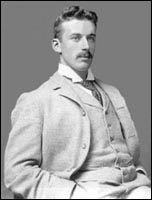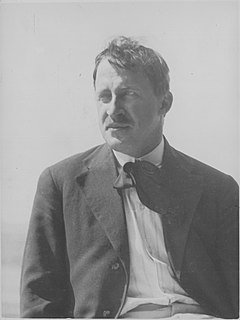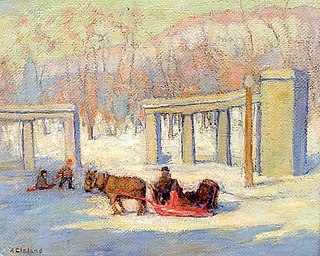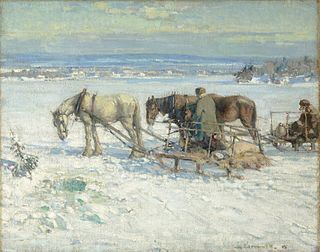Related Research Articles
The Beaver Hall Group refers to a Montreal-based group of Canadian painters who met in the late 1910s while studying art at a school run by the Art Association of Montreal. The Group is notable for its equal inclusion of men and women artists, as well as for its embrace of Jazz Age modernism. They painted a variety of subjects, including portraits, landscapes, urban scenes and still lifes, in a mix of Modernist and traditional styles.

Arthur Lismer, LL. D. was an English-Canadian painter, member of the Group of Seven and educator. He is known primarily as a landscape painter and for his paintings of ships in dazzle camouflage.

Alexander Young Jackson LL. D. was a Canadian painter and a founding member of the Group of Seven. Jackson made a significant contribution to the development of art in Canada, and was instrumental in bringing together the artists of Montreal and Toronto. He helped found the Group of Seven in 1920. In addition to his work with the Group of Seven, his long career included serving as a war artist during World War I (1917–19) and teaching at the Banff School of Fine Arts, from 1943 to 1949. In his later years he was artist-in-residence at the McMichael Canadian Art Collection in Kleinburg, Ontario.

Robert Harris was a Welsh-born Canadian painter, most noted for his portrait of the Fathers of Confederation.

Florence Helena McGillivray, also known as F H. McGillivray, was a Canadian landscape painter known for her Post-Impressionist style. Her family home was in Whitby, Ontario. She lived in Ottawa from 1914 to 1928. She was also a teacher. In 1916, on a visit to his studio, she encouraged Tom Thomson.
Painters Eleven was a group of abstract artists active in Canada between 1953 and 1960. They are associated with the Abstract Expressionist movement.

Helen Galloway McNicoll was a Canadian impressionist painter. She was one of the most notable women artists in Canada in the early twentieth century and achieved considerable success during her decade-long career. McNicoll played an important role in popularizing Impressionism in Canada, at a time when it was still relatively unknown, with her lively representations of rural landscapes, intimate child subjects and modern female figures. She was elected to the Royal Society of British Artists in 1913 and an Associate of the Royal Canadian Academy of Arts in 1914.

William Brymner, was a Canadian figure and landscape painter and educator. In addition to playing a key role in the development of Impressionism in Canada, Brymner taught numerous artists who became leading figures in Canadian modern art.
Canadian art refers to the visual as well as plastic arts originating from the geographical area of contemporary Canada. Art in Canada is marked by thousands of years of habitation by Indigenous peoples followed by waves of immigration which included artists of European origins and subsequently by artists with heritage from countries all around the world. The nature of Canadian art reflects these diverse origins, as artists have taken their traditions and adapted these influences to reflect the reality of their lives in Canada.
The Canadian Art Club was an artists' group established in Toronto in 1907 to advance the standards of Canadian art exhibitions and to exhibit the work of distinguished Canadian artists, particularly those who had studied abroad or lived there. It declined after the death of its co-founder Edmund Morris in 1913, ceased to exist in 1915 but was not formally dissolved till 1933.

Clarence Alphonse Gagnon, LL. D. was a French Canadian painter, draughtsman, engraver and illustrator. He is known for his landscape paintings of the Laurentians and the Charlevoix region of eastern Quebec.
Maurice Cullen is considered to be one of the first Impressionist artists in Canada. He is best known for his paintings of snow and for his ice harvest scenes where horse-drawn sleighs travel across the frozen waters of Quebec in the winter.
Henrietta Mabel May was a Canadian artist in the early 20th century. She helped organize two significant groups of Canadian artists and extended collegiality to women within those groups.
Emily Coonan was a Canadian impressionist and post-impressionist painter, born in the Pointe-Saint-Charles area of Montreal. As a member of the Beaver Hall Group, Coonan mostly did figure paintings. Influenced by William Brymner and James Wilson Morrice in early years and later on by work done in Europe, Coonan’s work has features that are related both to impressionism and modernism.

Mary Alberta Cleland was a Canadian Impressionist painter and educator.

Franklin Brownell born in New Bedford, Massachusetts was a landscape painter, draughtsman and teacher active in Canada. He artistic career in Ottawa spanned over fifty years.
William H. Clapp was a Canadian-American painter and art curator. He was a member of the Society of Six in Oakland, California, and an Impressionist landscape painter. He was also the curator of the Oakland Art Gallery.

John Young Johnstone was a Canadian Impressionist painter, known for his paintings of life in city, town or countryside, as well as for scenes of Montreal's Chinatown.
William Robinson Watson was an English-born Canadian art dealer who, through his staunch friendships with artists and his energetic enthusiasm for their work, helped establish the market for Canadian art. By the second half of the 1920s, he was Montreal's leading art dealer.
Arthur Dominique Rozaire was a Canadian impressionist painter, who painted landscape, and a photographer. His personal form of Impressionism, using broad expressive brushstrokes, evolved from Maurice Cullen, one of his teachers. He changed the spelling of his last name in the paintings he signed due to a misprint in an Art Association of Montreal Spring show catalogue of 1900.
References
- ↑ Prakash. 2015. p. xxv
- ↑ Adams, James (December 5, 2014). "Group of who? A new book paints the fullest picture yet of Canada's vision of Impressionism". The Globe and Mail. The Globe and Mail Inc.
- ↑ Pohl, John (February 5, 2015). "Visual arts: Montreal played key role in spread of Impressionism to Canada". Montreal Gazette. Postmedia Network Inc.
- ↑ Burton, Samantha (2017). Helen McNicoll: Life & Work. Toronto: Art Canada Institute. ISBN 978-1-4871-0152-7.
- ↑ Anderson, Jocelyn (2020). William Brymner: Life & Work. Toronto: Art Canada Institute. ISBN 978-1-4871-0238-8.
- ↑ Burton, Samantha (2017). Helen McNicoll: Life & Work. Toronto: Art Canada Institute. ISBN 978-1-4871-0152-7.
- ↑ Baldissera, Lisa (2015). Emily Carr: Life & Work. Toronto: Art Canada Institute. ISBN 978-1-4871-0044-5.
- ↑ Burton, Samantha (2017). Helen McNicoll: Life & Work. Toronto: Art Canada Institute. ISBN 978-1-4871-0152-7.
- ↑ Anderson, Jocelyn (2020). William Brymner: Life & Work. Toronto: Art Canada Institute. ISBN 978-1-4871-0238-8.
- ↑ Anderson, Jocelyn (2020). William Brymner: Life & Work. Toronto: Art Canada Institute. ISBN 978-1-4871-0238-8.
- ↑ Anderson, Jocelyn (2020). William Brymner: Life & Work. Toronto: Art Canada Institute. ISBN 978-1-4871-0238-8.
- ↑ Burton, Samantha (2017). Helen McNicoll: Life & Work. Toronto: Art Canada Institute. ISBN 978-1-4871-0152-7.
- ↑ Burton, Samantha (2020). Helen McNicoll: Life & Work. Toronto: Art Canada Institute. ISBN 978-1-4871-0152-7.
- ↑ Burton, Samantha (2017). Helen McNicoll: Life & Work. Toronto: Art Canada Institute. ISBN 978-1-4871-0152-7.
- ↑ Burton, Samantha (2017). Helen McNicoll: Life & Work. Toronto: Art Canada Institute. ISBN 978-1-4871-0152-7.
- ↑ Prakash. 2015. p. 11
- 1 2 3 Kerr, Matthew (25 July 2019). "French Canadians – how Impressionism caught on in the Great White North". Apollo magazine. Retrieved 2 February 2020.
- 1 2 3 "Visions of Light and Air: Canadian Impressionism, 1885-1920". Americas Society / Council of the Americas. Retrieved 23 May 2017.
- ↑ Prakash. 2015. p. 491ff
- ↑ Prakash. 2015. p. 418ff
- ↑ Sandals, Leah (24 July 2019). "Canadian Impressionism Show Offers Unprecedented View of Overlooked Art-Historical Chapter". canadianart. Retrieved 2 February 2020.
- ↑ MacGregor, Roy (29 January 2022). "National Gallery to open special exhibition celebrating the Canadian Impressionists". The Globe and Mail. Retrieved 30 January 2022.
Sources
- Anderson, Jocelyn. William Brymner: Life & Work. Toronto: Art Canada Institute, 2020. ISBN 978-1-4871-0238-8
- Baldissera, Lisa. Emily Carr: Life & Work. Toronto: Art Canada Institute, 2015. ISBN 978-1-4871-0044-5
- Burton, Samantha. Helen McNicoll: Life & Work. Toronto: Art Canada Institute, 2017. ISBN 978-1-4871-0152-7
- Prakash, A.K. Impressionism in Canada: A Journey of Rediscovery. Stuttgart: Arnoldsche Art Publishers, 2015. ISBN 978-3-89790-427-9
- Lowrey, Carol, Visions of Light and Air: Canadian Impressionism, 1885-1920, Americas Society, 1996.
